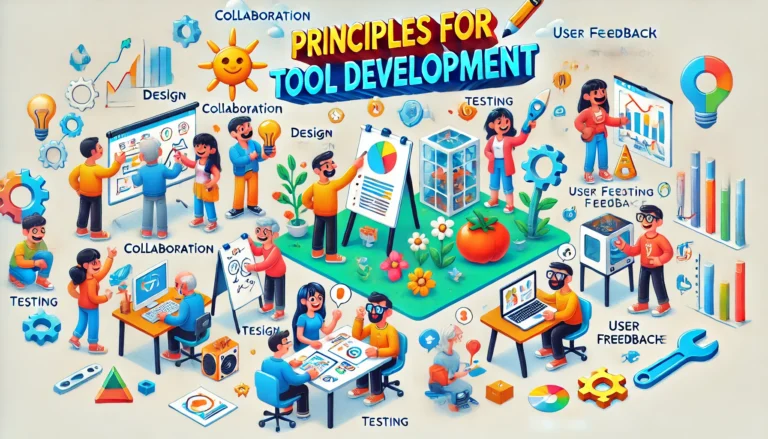The tool development in qualitative research is a crucial factor that guarantees the validity, reliability, and depth of the acquired data. Qualitative tools, in contrast to standardized instruments used in quantitative research, tend to be customized and specific to the setting. The tools encompass interview guides, observation protocols, and focus group discussions, all specifically developed to collect qualitative data.
Common Qualitative Research Tools
Common instruments and methodologies employed for data collecting in qualitative research include:
- Interviews
- Focus Group Discussions
- Observations
Interviews
Tool development in qualitative research usually focus on interviews for collecting primary data. Here we discuss three types of interviews;
In-depth Interviews
In-depth interviews involve conducting face-to-face communication with participants, during which the researcher poses open-ended questions to gain insight into their perspectives.
Semi-structured Interviews
Semi-structured interviews involve a predetermined series of questions but also provide room for the interviewer to go deeper into issues based on the participant’s replies.
Unstructured Interviews
These interviews are characterized by a conversational style and lack predetermined questions, giving the participant the freedom to direct the conversation.
Qualitative Interview
A qualitative interview is a kind of communication between an interviewer and a respondent, where the interviewer has a broad outline of topics to discuss but does not have a predetermined list of questions that must be addressed in a precise manner or sequence. A qualitative interview is simply a dialogue where the interviewer sets the overall course of the conversation and explores individual subjects picked up by the interviewee. Preferably, the person being asked questions should do the most of the speaking. If you are speaking more than 5 per cent of the time, it is likely that you are speaking excessively.
Types of Qualitative Interviews

Qualitative interviewing typically involves asking open-ended questions and does not follow a rigid pattern. There are three types of qualitative, open-ended interviewing:
Informal Conversational Interview
An informal conversational interview refers to an informal and unplanned exchange between an interviewer and a respondent that takes place organically while doing fieldwork observation.
Interview Guide Approach
The interview guide approach in qualitative interviewing involves using an outline to list the topics and issues that the interviewer should address during the interview. However, it also allows the interviewer to customize the order and wording of the questions for each specific interview.
Standardized Open-ended Interview
The standardized open-ended interview is a method where questions are prepared in advance and asked exactly as written throughout the interview.
Focus Groups Discussions
In Group discussions, a moderator guides a group of participants to collectively explore and share their perspectives, experiences, and opinions on a certain topic. Studying social dynamics and group interactions is beneficial for gaining insight into these phenomena. In order to establish a focus group, researchers gather members and monitor their interactions while they dig into a certain subject.
Observation
Participant Observation
The researcher fully engages in the area under study, actively participating in the activities while making observations.
Non-Participant Observation
The researcher observes the environment without engaging or taking part in any activities.
Principles for Tool Development in Qualitative Research
Tool development in qualitative research is governed by various fundamental principles that guarantee the tools are suitable for their intended use and in line with the research objectives:

Flexibility
The Tool development in qualitative research frequently necessitates adaptation since the research process can be continuous and sensitive to incoming findings. Tools should include sufficient adaptability to accept alterations in the study focus or approach.
Context-Sensitivity
Qualitative instruments need to be sensitive and aware of the socio-cultural context in which the research is being conducted. This guarantees that the tools are suitable for the context and align with the participants’ experiences.
Participant-Centered Design
In the process of tool development in qualitative research, you should focus on the participants, ensuring that questions are easy to use, considerate, and able to accurately capture the participants’ opinions and viewpoints.
Transparency
Transparency in tool development in qualitative research includes detailed documentation of the design process, the underlying reasoning for the tool’s structure, and its intended utilization. Transparency is essential to guarantee the credibility and reliability of the study.
Ethical Concerns
It is crucial to prioritize ethical concerns throughout tool creation to guarantee that the tools uphold the dignity, rights, and well-being of participants.
Process of Tool Development in Qualitative Research
In the process of tool development in qualitative research, encompasses many crucial stages, each of which plays a role in enhancing the effectiveness and suitability of the tools:
Develop Research Objectives and Questions
Initially, the process of tool development in qualitative research entails the precise formulation of the study objectives and questions. These guidelines will direct the design of the instruments, guaranteeing that they are in line with the objectives of the research and capable of collecting the required data.
Reviewing of Literature
During the process of tool development in qualitative research, researchers should conduct a thorough examination of current tools and pertinent literature in order to ascertain the most effective methods, prevent redundancy, and expand upon previous studies. This review facilitates comprehension of others’ contributions and identifies potential areas for enhancement.
Tool Development
The design phase encompasses the development of the framework and contents of the instrument. When creating an interview guide, researchers will choose the main subjects, the sequence of questions, and the phrasing to guarantee readability and transparency. This stage may also entail the development of observation procedures or coding frameworks.
Pilot Testing
When you have completed the process of tool development in qualitative research, the tool should be tested with a small group of participants. Pilot testing enables researchers to detect any potential problems with the instrument, such as unclear questions or practical difficulties. According on the input, the tool may be enhanced to increase its efficacy.
Execution of Tool
Once the tool has been refined, it is now prepared for use in the primary investigation. During the implementation phase, researchers should maintain an open mindset towards making additional modifications since the practical application of their work may uncover novel observations or obstacles.
Documentation
Comprehensive documentation of the process of developing the instrument is crucial to guarantee transparency and reliability in qualitative research. The documentation should encompass the justification behind design decisions, the process of testing and improving, and any modifications made during execution.
Quantitative and Qualitative Questions for Data Collection

The main difference between quantitative and qualitative measures in surveying individuals lies in their structure and question types. Quantitative measures are characterized by high structure, mainly employing closed-ended questions, and can be administered through interviews or questionnaires. In contrast, qualitative measures rely on unstructured interviews, featuring mainly open-ended questions that include detailed probes. Qualitative researchers frequently conduct in-depth interviews with participants, which are considerably less structured compared to interviews performed in survey research.
| Measurement Principles | Quantitative Approach | Qualitative Approach |
| Try to use language that respondents will understand | Always | Always |
| Ask one question at a time; avoid double-barrelled questions | Always | Always |
| Only ask questions that respondents are capable of answering and that are relevant to them | Always | Always |
| Avoid biased items and terms Stylistic Differences | Always | Always |
| Questionnaires or scale | Often | Rarely |
| Interviews | Sometimes | Usually |
| Same wording and sequence of questions for all respondents | Always | Rarely |
| Interviewer flexibility regarding wording, sequencing, and conversational style | Never | Very often |
| Open-ended questions | Rarely | Usually |
| Probes | Rare and brief | Frequent and in-depth |
| Closed-ended questions | Usually | Sometimes |
| Formality of interview | Relaxed, friendly demeanor, but professional tone and not overly casual | More likely to resemble a spontaneous, informal, friendly conversation |






